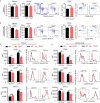CD47 Deficiency Ameliorates Ocular Autoimmune Inflammation
- PMID: 34093583
- PMCID: PMC8174453
- DOI: 10.3389/fimmu.2021.680568
CD47 Deficiency Ameliorates Ocular Autoimmune Inflammation
Abstract
Autoimmune uveitis is a sight-threatening ocular inflammatory condition in which the retina and uveal tissues become a target of autoreactive immune cells. The CD47 is a ubiquitously expressed transmembrane protein which plays multiple roles in fundamental cellular functions including phagocytosis, proliferation, and adhesion. Signal regulatory protein alpha (SIRPα), one of the CD47 ligands, is predominantly expressed in myeloid lineage cells such as dendritic cells (DCs) or macrophages, and CD47-SIRPα signaling pathway is implicated in the development of autoimmune diseases. Our current study demonstrates how CD47 depletion is effective in the prevention of experimental autoimmune uveitis (EAU), an animal model of human autoimmune uveitis, in animals deficient of CD47 (CD47-/- ). Systemic suppression of SIRPα+ DCs in animals deficient in CD47 resulted in the inability of autoreactive CD4+ T cells to develop, which is crucial to induction of EAU. Of interest, retinal microglia, the resident immune cell of the retina, express SIRPα, however these cells were not operative in EAU suppression in response to CD47 depletion. These results identify CD47 as a significant regulator in the development of SIRPα+ DCs that is vital to disease induction in EAU.
Keywords: CD47 antigen; antigen-presenting cells; autoimmune diseases; retina; uveitis.
Copyright © 2021 Okunuki, Tabor, Lee and Connor.
Conflict of interest statement
The authors declare that the research was conducted in the absence of any commercial or financial relationships that could be construed as a potential conflict of interest.
Figures







Similar articles
-
Mincle Activation and the Syk/Card9 Signaling Axis Are Central to the Development of Autoimmune Disease of the Eye.J Immunol. 2016 Apr 1;196(7):3148-58. doi: 10.4049/jimmunol.1502355. Epub 2016 Feb 26. J Immunol. 2016. PMID: 26921309 Free PMC article.
-
MHC class II expression and potential antigen-presenting cells in the retina during experimental autoimmune uveitis.J Neuroinflammation. 2017 Jul 18;14(1):136. doi: 10.1186/s12974-017-0915-5. J Neuroinflammation. 2017. PMID: 28720143 Free PMC article.
-
Suppression of the Reactive Oxygen Response Alleviates Experimental Autoimmune Uveitis in Mice.Int J Mol Sci. 2020 May 5;21(9):3261. doi: 10.3390/ijms21093261. Int J Mol Sci. 2020. PMID: 32380695 Free PMC article.
-
The Role of αA-Crystallin in Experimental Autoimmune Uveitis.Curr Mol Med. 2015;15(6):558-64. doi: 10.2174/1566524015666150731101146. Curr Mol Med. 2015. PMID: 26238368 Review.
-
Anti-inflammatory and immune-modulatory impacts of berberine on activation of autoreactive T cells in autoimmune inflammation.J Cell Mol Med. 2020 Dec;24(23):13573-13588. doi: 10.1111/jcmm.16049. Epub 2020 Nov 1. J Cell Mol Med. 2020. PMID: 33135395 Free PMC article. Review.
Cited by
-
Loss of CD47 alters CD8+ T cell activation in vitro and immunodynamics in mice.Oncoimmunology. 2022 Sep 6;11(1):2111909. doi: 10.1080/2162402X.2022.2111909. eCollection 2022. Oncoimmunology. 2022. PMID: 36105746 Free PMC article.
-
Targeting SLC22A5 fosters mitophagy inhibition-mediated macrophage immunity against septic acute kidney injury upon CD47-SIRPα axis blockade.Heliyon. 2024 Feb 22;10(7):e26791. doi: 10.1016/j.heliyon.2024.e26791. eCollection 2024 Apr 15. Heliyon. 2024. PMID: 38586373 Free PMC article.
-
Retinal Injury Activates Complement Expression in Müller Cells Leading to Neuroinflammation and Photoreceptor Cell Death.Cells. 2023 Jun 30;12(13):1754. doi: 10.3390/cells12131754. Cells. 2023. PMID: 37443787 Free PMC article.
-
Regulation of CD47 expression on CD14+ monocytes by interferon-α in PBC patients.Front Immunol. 2023 Dec 4;14:1256995. doi: 10.3389/fimmu.2023.1256995. eCollection 2023. Front Immunol. 2023. PMID: 38111586 Free PMC article.
-
Beyond cancer: The potential application of CD47-based therapy in non-cancer diseases.Acta Pharm Sin B. 2025 Feb;15(2):757-791. doi: 10.1016/j.apsb.2024.11.018. Epub 2024 Nov 28. Acta Pharm Sin B. 2025. PMID: 40177549 Free PMC article. Review.
References
Publication types
MeSH terms
Substances
Grants and funding
LinkOut - more resources
Full Text Sources
Other Literature Sources
Medical
Molecular Biology Databases
Research Materials

